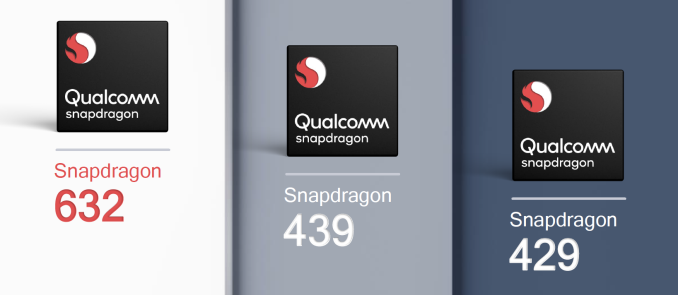Qualcomm Announces Snapdragon 632, 439 and 429 - Expanding the Low-Mid-tier
by Andrei Frumusanu on June 26, 2018 9:00 PM EST
A month ago we saw Qualcomm release a new “upper mid-range” SoC with the announcement of the Snapdragon 710 – the emphasis was on the fact that this was a new market tier aiming slightly below the top-tier flagship chipsets. Today, we’re seeing Qualcomm expand the traditional mid-tier and also what can be considered the low-end for smartphone devices. The Snapdragon 439 and 429 follow in the footsteps of the 435 and 425 and bring FinFET to the low-end; the Snapdragon 632 is more akin to the Snapdragon 652 as it’s now the first time we see big cores brought down to the lower mid-tier successor to the Snapdragon 630.
| New 2018 Mid & Low-End Snadpragons | ||||
| SoC | Snapdragon 632 | Snapdragon 439 | Snapdragon 429 | |
| CPU | 4x Kryo 250 (CA73) @ 1.8GHz 4x Kryo 250 (CA53) @ 1.8GHz |
4x A53 @ 1.95GHz 4x A53 @ 1.45 GHz |
4x A53 @ 1.95 | |
| GPU | Adreno 506 | Adreno 505 | Adreno 504 | |
| Modem | "X9 LTE" Cat. 7/13 300Mbps DL 150Mbps UL 4x10MHz C.A. (DL & 2CA UL) |
"X6 LTE" Cat. 4/5 150Mbps DL 75Mbps UL 2x10MHz C.A. (DL) |
||
| Camera/ISP | Dual ISP 24MP / 13+13MP |
Dual ISP 21MP / 8+8MP |
Dual ISP 16MP / 8+8MP |
|
| Mfc. Process | 14nm FinFET | 12nm FinFET | ||
Starting off with the Snapdragon 632, the new SoC is positioned as a successor to the Snapdragon 630. The 600 series suffered from quite a bit of naming confusion as we saw very large performance differences between the 65x and 66x series and the lower numbered ones such as the Snapdragon 630, 615 and 617 – this was largely due to the fact that the lower 600 series SoCs were missing the processing power of larger “big” CPU microarchitecture cores, while the 650 and up were effectively positioned as more expensive tiers.
The Snapdragon 632 now continues this lower-tiered positioning within the 600 series, but brings for the first time the performance benefit of big cores to this price segment. For these big cores we find 4x Kryo 250s running at up to 1.8GHz. Qualcomm didn’t confirm what CPU core this is based on, but looking at the CPUID of an unannounced device it matches the Cortex A72 and this would also make sense given the lower Kryo 2xx naming scheme. Qualcomm reached back confirming these are Cortex A73s. The big cores are paired with another 4x Kryo 250s – but again we’re effectively talking about Cortex A53 cores as the little cores in the efficiency cluster.
Meanwhile the Snapdragon 439 and 429 are direct successors to the 435 and 425. Like the S435, the S439 is a 8x A53 setup with a performance cluster going up to 1.95GHz while the second efficiency cluster goes up to 1.45GHz. The S429 is a simple single-cluster with 4x Cortex A53’s up to 1.95GHz and comes with a more updated Adreno 504 over the 425’s older Adreno 308, with the largest quoted performance improvement of up to 50%.
One of the most important characteristics of these new low-end SoCs is however that they’re manufactured on FinFET nodes – Qualcomm didn’t specify exactly the foundry or exact node but we’re likely talking about 14LPP or a 16FF variant, with the possibility of Qualcomm also third-sourcing these from UMC as well. Qualcomm reveals on its website the 632 is 14nm which likely points to Samsung 14LPP, and the 439 and 429 are listed as 12nm which points out to 12FFC from TSMC. This marks a generational shift as we see Qualcomm effectively have completed a total transition to FinFET products across its whole mobile SoC product line.
A large commercial advantage of the new chips is their design compatibility; the Snapdragon 632, 439, 429 are software compatible with each other and with the existing 626, 625 and 450 platforms. Furthermore the 632 is pin compatible with the 626, 625 and 450, and the 439 and 429 are pin compatible with each other. The software compatibility allows for a smaller resource investment on the part of OEMs and an accelerated time-to-market for devices. In particular, what seems to be very interesting here is the 632 being pin compatible with several older chips – It would be great to see OEMs be able to release quick refreshes of their devices with the new chip given that it’ll bring large performance improvements thanks to the new big CPU cores.
Overall the new mid- and low-end Snapdragons bring a generational improvement thanks to Qualcomm’s total switch to FinFET nodes across all of its line-up. The new SoC platforms are quoted be used in commercial devices released in the second half of 2018, which essentially means very soon.




















33 Comments
View All Comments
LiviuTM - Wednesday, June 27, 2018 - link
https://en.wikipedia.org/wiki/List_of_Qualcomm_Sna...By looking at specs, I'd say it's on a higher tier - better GPU, better memory controller, better DSP, better modem.
psychobriggsy - Wednesday, June 27, 2018 - link
I expect the difference between the CPU cores in the 636 (Kryo 260) and this new 632 (Kryo 250) comes down to the cache configuration. I don't understand why that listing says LPDDR3 for the 632, when all the others are LPDDR4 and it's supposedly pin compatible - that must be a mistake on the page. Ditto the older DSP, surely another mistake.Surprised they are putting 4 big cores on this SKU, but it looks like the clock speeds aren't high, so probably a dense layout was used. Dunno if it's the same die as the 636 but cut down a little.
anonym - Wednesday, June 27, 2018 - link
632 is pin compatible with 625 not 636.skavi - Wednesday, June 27, 2018 - link
Could that 429 be used as a smartwatch SoC? With 14nm, it's probably lower power than anything currently available, but it would be nice if it used a low power cluster.69369369 - Wednesday, June 27, 2018 - link
Yawn, more SOCs with underpowered adreno 50x graphics.peevee - Wednesday, June 27, 2018 - link
Right, because everybody plays 3D games on their phones with screens with invisibly high resolutions.Not.
AntonErtl - Wednesday, June 27, 2018 - link
Given that the Cortex-A73 is smaller and thus cheaper to produce than the A72, I would not expect new designs with the A72, unless they can reuse a substantial part of the fine-tuning that they invested in the A72.Spunjji - Wednesday, June 27, 2018 - link
Their naming scheme is beating even Intel in terms of sheer bat-shit madness. Seriously, if I need to consult an encyclopedia just to tell whether a higher or lower numbered chip is better then something has gone badly wrong.peevee - Wednesday, June 27, 2018 - link
MBA infestation is apparent @ Qualcomm. :(Plumplum - Wednesday, June 27, 2018 - link
On 632, Kryo 250 means probably Cortex A73, like other Kryo 2x0- 280 Gold on SD835 is cortex A73 with 2x32bits LPDDR4
- 260 Gold on SD660/636 is A73 with 2x16bits LPDDR4 (bandwidth isn't the same it's obviously not 2x32 like some Anandtech articles said)
- In my opinion, 250 will probably use LPDDR3 to fit with Adreno 506.
It's really easy to compare kryo and cortex A73 on detailled geekbench's scores.
632 is a cheaper 636 with weaker GPU, weaker Memory, weaker...as 636 is allready behind P60 in many aspects including GPU, this 632 will not compete.
439 and 429 are response to Helio P22 and A22, in term of AI and process node.
It's funny to see the economic choices of Qualcomm and Mediatek :
On 439/429, back to lte category 4, reduce GPU and keeping fullhd support.
On P22/A22, upgrade to lte category 7, LPDDR4, bluetooth 5, newer powerVR8 GPU but limited to HD+
Usually Qualcomm is known for lte and GPU, these reductions sound strange